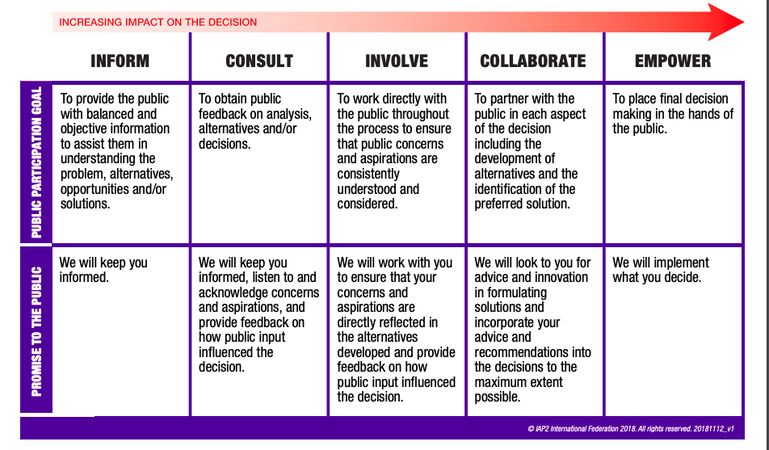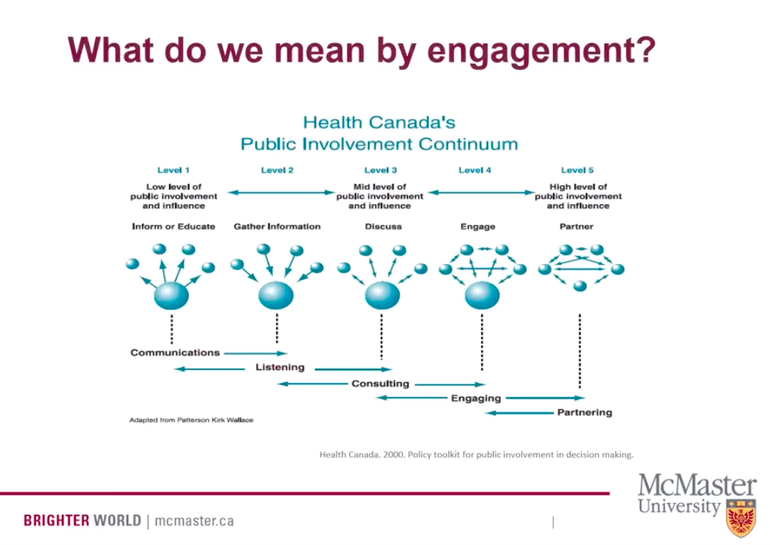|
This past week has very much been ALL about patient and public engagement; where we have been, where we are and Are We There Yet? First up was listening to Carolyn Canfield's Top Ten Insights in Citizen Engagement (a Canadian perspective) during the McMaster Health Forum webinar. For those of you who don't know Carolyn, she is a pioneer in citizen engagement and patient safety, taking her tragic experience of losing her husband 8 days after surgery and redirecting that experience into deep impact around quality and safety of care in Canadian health care. Second, was watching Julia Ableson's presentation on Patient and Pubic Engagement; Are We There Yet? Dr. Ableson is the lead for the Public and Patient Engagement Research - Practice Collaborative also through McMaster. Third, was sitting in a board room with a fellow patient partner and one of our PhD researcher colleagues discussing supporting and building capacity in patient partners and researchers around patient orientated research. Now I am not terribly familiar with Dr. Ableson's work, however, a few things she shared resonated. And when I went to my meeting one thing popped up in regards to patient engagement and the IAP2 (International Association of Public Participation) spectrum of engagement that has been adopted by many in the world of patient orientated research and patient engagement. Julia actually used an older version of patient and public engagement and I didn't get a chance to ask her to share why. However, it became a focal point of my discussion later that day with my colleagues. One of the comments my PhD researcher had was that we should focus on Involve, Collaborate or Discuss, Engage. His reasoning was that there is no way we will EVER get PhD researchers to 'give up control' in order for us to reach Level 5, or Empowerment in the work of patient engagement. It took me a few minutes to wrap my head around that and then I remembered Dr. Ableson's image of the public involvement continuum. And I began to reflect on my own lived experience as a caregiver navigating the health care system for two decades. My experience, despite the gut wrenching loss of my daughter in the end, has been, for the most part, a good experience with little conflict or confrontation with the plethora of health care providers we encountered.
Sensing my colleagues resolve that empowerment is a 'nice to' but 'never will be' made me feel a bit deflated. But then I shared Dr. Ableson's version of public involvement and said, look at the image used of that far right level. All the balls are the same size. I challenged the notion of power and that IF power is the hurdle to empowerment then we need to redefine what empowerment means in the IAP2 model. What I think we need to start doing and articulating is that empowerment isn't about one stakeholder having MORE power over another; ie, patient over researcher, perhaps researcher over patient. Empowerment, in its truest sense, is ALL stakeholders having equity at the table, no one group has more power. And that true empowerment in patient and public engagement is about how all of us engage and interact together for the greater good; be it research, bettering health outcomes, designing health systems, or even at the basic level...alleviating pain and symptoms of a patient or loved one. Had I not had a true partnership with my daughter, Sophia's, health care practitioners and community support workers, I am not sure her journey would have been as 'good' as it was. And ultimately, she may have died experiencing a lot more pain and discomfort than she did. My challenge to both patient partners and those in health care (researchers, health care leaders, patient engagement specialists) is that Level 5 or Empowerment IS possible...if we all come to the table with equity. And what we come to the table with, is less about power and more about forging partnerships. Interestingly enough, Carolyn Canfield's presentation was symbiotic to Julia Ableson's despite both these presenters looking at patient and public engagement from two very different lens. Which kind of makes the point... As I embark on this new iteration of my life, professionally and personally, I am committed to working towards that Level 5 of Empowerment in order to impact change. I desire to build partnerships and am keen to learn and share. I am grateful that my PhD research colleague, despite our different lens, also became excited at this redefinition of Empowerment in the work we are just beginning. And I imagine we are going to do wonderful things together...that will have lasting, meaningful impact.
0 Comments
Your comment will be posted after it is approved.
Leave a Reply. |
AuthorBeverley Pomeroy is an awarded and highly sought after Community Engagement Strategist, Speaker, Author of Living Grief; The Profound Journey of Ongoing Loss. Beverley’s community service began with a fifteen year career in private health care working for MDS Inc (LifeLabs). This community health care role developed her acumen not only for serving people in need, but also her strength in business management and organizational renewal. Archives
December 2021
Categories |



 RSS Feed
RSS Feed